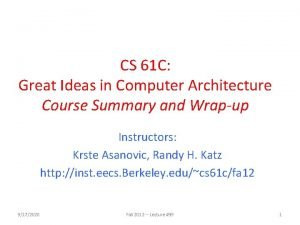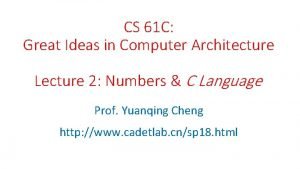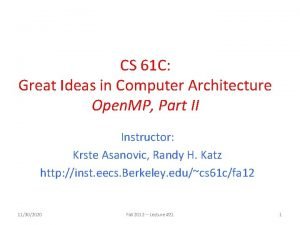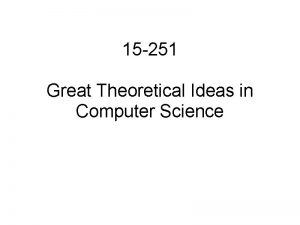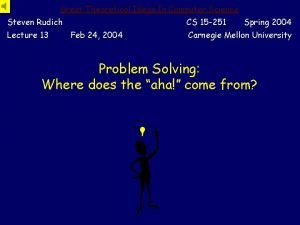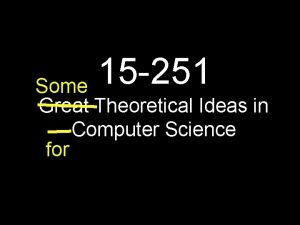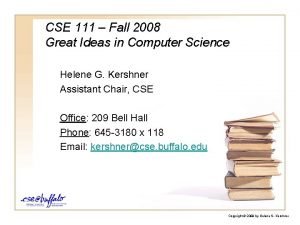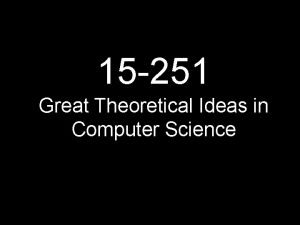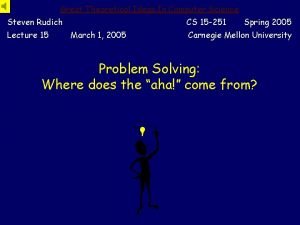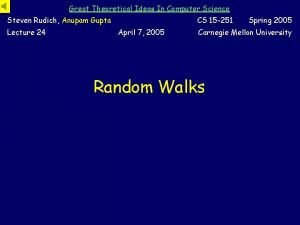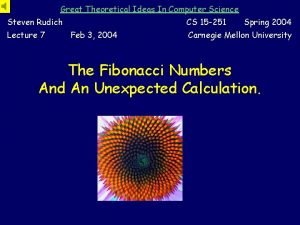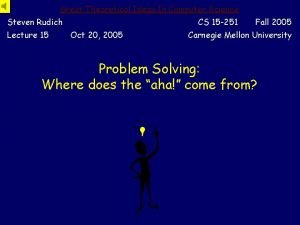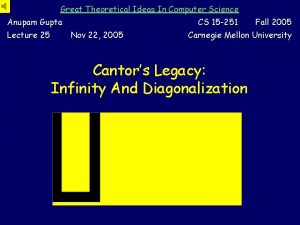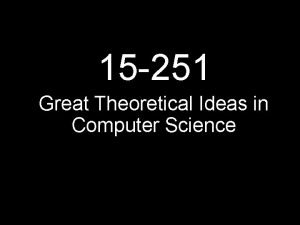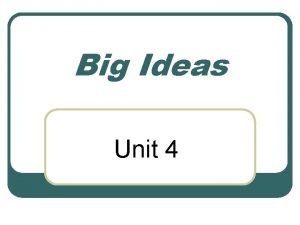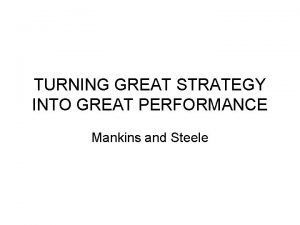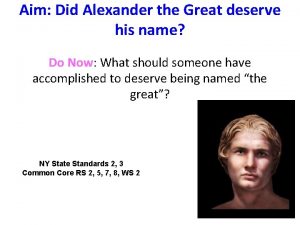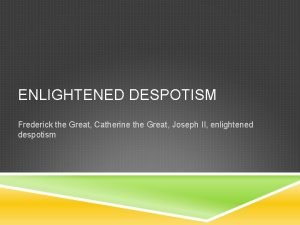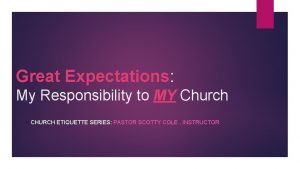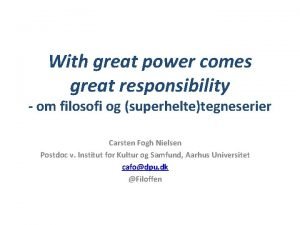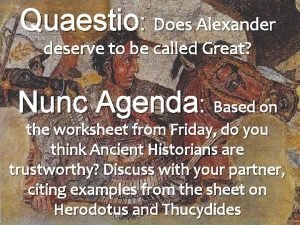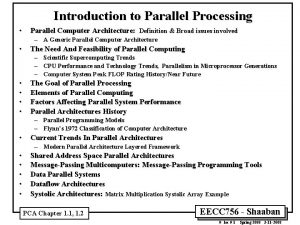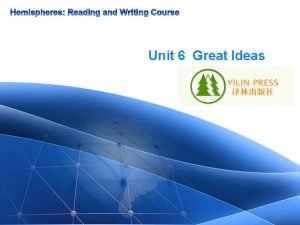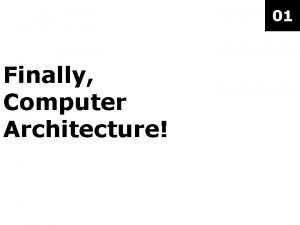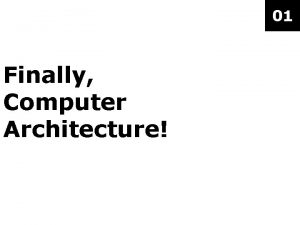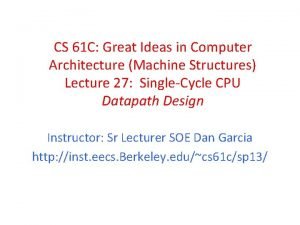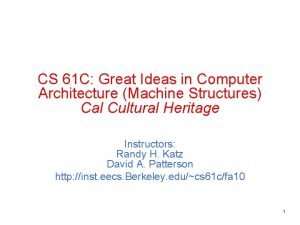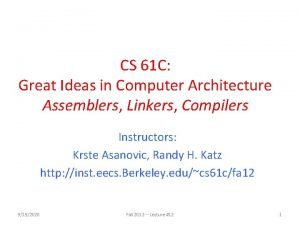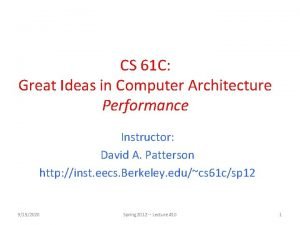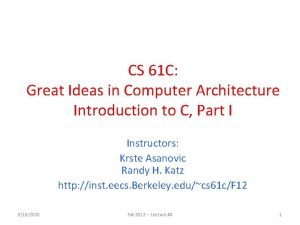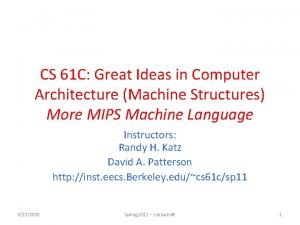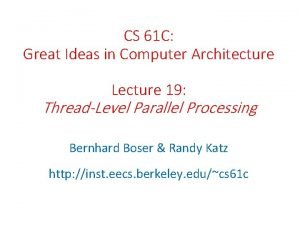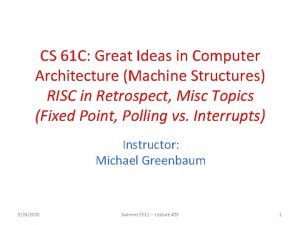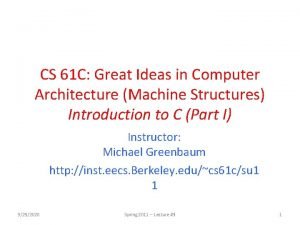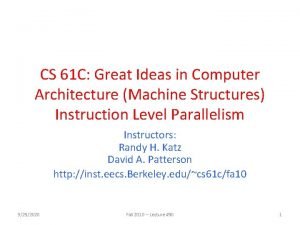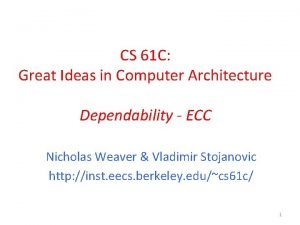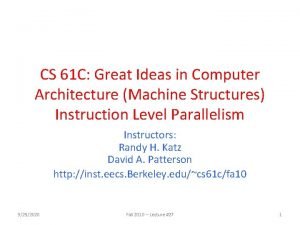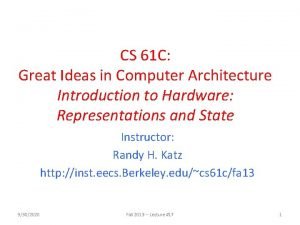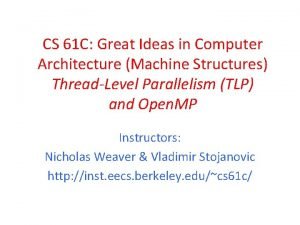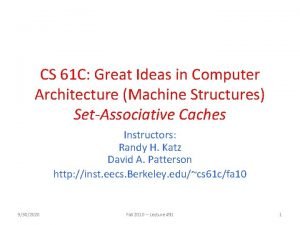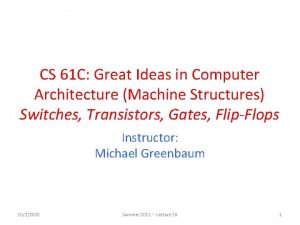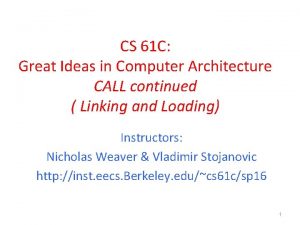CS 61 C Great Ideas in Computer Architecture
























































- Slides: 56

CS 61 C: Great Ideas in Computer Architecture (a. k. a. Machine Structures) Lecture 1: Course Introduction, Number Representation Instructor: Sagar Karandikar (call me “Sagar”) sagark@eecs. berkeley. edu 1

About Your Instructor • I graduated in May 2015 with a B. S. in EECS at Berkeley • I am starting the Ph. D. program in CS at Berkeley in Fall 2015, focusing in Computer Architecture My CS 61 C History: Position Student TA Head TA Semester Fall 2012 Spring 2013 Summer 2013 TA TA Head TA Fall 2013 Spring 2014 Fall 2014 Spring 2015

Agenda • • Thinking about Machine Structures Great Ideas in Computer Architecture What you need to know about this class Everything is a Number 3

Agenda • • Thinking about Machine Structures Great Ideas in Computer Architecture What you need to know about this class Everything is a Number 4

CS 61 C is NOT really about C Programming • It is about the hardware-software interface – What does the programmer need to know to achieve the highest possible performance? • C is closer to the underlying hardware, unlike languages like Scheme, Python, Java! – Allows us to talk about key hardware features in higher level terms – Allows programmer to explicitly harness underlying hardware parallelism for high performance 5

Old School CS 61 C 6

New School CS 61 C (1/3) Personal Mobile Devices 7

New School CS 61 C (2/3) 8

New School CS 61 C (3/3) 9

Old School Machine Structures Application (ex: browser) Compiler Software Hardware Assembler Processor Operating System (Mac OSX) Memory I/O system CS 61 C Instruction Set Architecture Datapath & Control Digital Design Circuit Design transistors 10

New-School Machine Structures (It’s a bit more complicated!) Lab 13 Software • Parallel Requests Assigned to computer e. g. , Search “Katz” • Parallel Threads Assigned to core e. g. , Lookup, Ads Hardware Harness Parallelism & Achieve High Performance • Parallel Instructions >1 instruction @ one time e. g. , 5 pipelined instructions • Parallel Data >1 data item @ one time e. g. , Add of 4 pairs of words • Hardware descriptions All gates functioning in parallel at same time Smart Phone Warehouse -Scale Computer Project 1, 2 Computer … Core Memory Core (Cache) Input/Output Instruction Unit(s) Project 4 Core Functional Unit(s) A 0+B 0 A 1+B 1 A 2+B 2 A 3+B 3 Main Memory Logic Gates Project 11 3

Agenda • • Thinking about Machine Structures Great Ideas in Computer Architecture What you need to know about this class Everything is a Number 12

6 Great Ideas in Computer Architecture 1. Abstraction (Layers of Representation/Interpretation) 2. Moore’s Law (Designing through trends) 3. Principle of Locality (Memory Hierarchy) 4. Parallelism 5. Performance Measurement & Improvement 6. Dependability via Redundancy 13

Great Idea #1: Abstraction (Levels of Representation/Interpretation) High Level Language Program (e. g. , C) Compiler Assembly Language Program (e. g. , MIPS) Assembler Machine Language Program (MIPS) temp = v[k]; v[k] = v[k+1]; v[k+1] = temp; lw lw sw sw 0000 1010 1100 0101 $t 0, 0($2) $t 1, 4($2) $t 1, 0($2) $t 0, 4($2) 1001 1111 0110 1000 1100 0101 1010 0000 Anything can be represented as a number, i. e. , data or instructions 0110 1000 1111 1001 1010 0000 0101 1100 1111 1000 0110 0101 1100 0000 1010 1000 0110 1001 1111 Machine Interpretation Hardware Architecture Description (e. g. , block diagrams) Architecture Implementation Logic Circuit Description (Circuit Schematic Diagrams) 14

# of transistors on an integrated circuit (IC) #2: Moore’s Law Predicts: 2 X Transistors / chip every 2 years Gordon Moore Intel Cofounder B. S. Cal 1950! Year 15

Interesting Times Moore’s Law was based on how many transistors/chip at cheapest cost/transistor as technology scaled. BUT newest, smallest fabrication processes <14 nm, might have greater cost/transistor !!!! So, why shrink? ? Moore’s Law 1965 -2020? 16

Jim Gray’s Storage Latency Analogy: How Far Away is the Data? 10 9 10 10 2 1 Tape /Optical Robot 6 Disk Memory On Board Cache On Chip Cache Registers Andromeda Pluto Sacramento This Campus 2, 000 Years Jim Gray Turing Award B. S. Cal 1966 2 Years Ph. D. Cal 1969! 1. 5 hr 10 min This Room 1 min My Head (ns)

Great Idea #3: Principle of Locality/ Memory Hierarchy 11/27/2020 18

Great Idea #4: Parallelism 19

Caveat: Amdahl’s Law Gene Amdahl Computer Pioneer 11/27/2020 20

Great Idea #5: Performance Measurement and Improvement • Tuning application to underlying hardware to exploit: – Locality – Parallelism – Special hardware features, like specialized instructions (e. g. , matrix manipulation) • Latency – How long to set the problem up – How much faster does it execute once it gets going – It is all about time to finish 21

Coping with Failures • 4 disks/server, 50, 000 servers • Failure rate of disks: 2% to 10% / year – Assume 4% annual failure rate • On average, how often does a disk fail? a) b) c) d) 1 / month 1 / week 1 / day 1 / hour 22

Coping with Failures • 4 disks/server, 50, 000 servers • Failure rate of disks: 2% to 10% / year – Assume 4% annual failure rate • On average, how often does a disk fail? a) b) c) d) 1 / month 1 / week 1 / day 1 / hour 50, 000 x 4 = 200, 000 disks 200, 000 x 4% = 8000 disks fail 365 days x 24 hours = 8760 hours 23

NASA Fixing Rover’s Flash Memory • Opportunity still active on Mars after >10 years • But flash memory worn out • New software update will avoid using worn out memory banks http: //www. engadget. com/2014/12/30/nasa-opportunity-rover-flash-fix/ 24

Great Idea #6: Dependability via Redundancy • Redundancy so that a failing piece doesn’t make the whole system fail 1+1=2 2 of 3 agree 1+1=2 1+1=1 FAIL! Increasing transistor density reduces the cost of redundancy 25

Great Idea #6: Dependability via Redundancy • Applies to everything from datacenters to storage to memory – Redundant datacenters so that can lose 1 datacenter but Internet service stays online – Redundant disks so that can lose 1 disk but not lose data (Redundant Arrays of Independent Disks/RAID) – Redundant memory bits of so that can lose 1 bit but no data (Error Correcting Code/ECC Memory) 26

Agenda • • Thinking about Machine Structures Great Ideas in Computer Architecture What you need to know about this class Everything is a Number 27

Yoda says… “Always in motion, the future is…” Our schedule may change slightly depending on some factors. This includes lectures, assignments & labs…

Weekly Schedule 29

Course Information • Course Web: http: //inst. eecs. berkeley. edu/~cs 61 c/ • Instructor: – Sagar Karandikar • Teaching Assistants, Tutors, Readers: (see next slide) • Textbooks: Average 15 pages of reading/week (can rent!) – Patterson & Hennessey, Computer Organization and Design, 5/e (we’ll also provide Revised 4 th Ed pages, not Asian version 4 th edition) – Kernighan & Ritchie, The C Programming Language, 2 nd Edition – Barroso & Holzle, The Datacenter as a Computer, 2 nd Edition • Piazza: – Every announcement, discussion, clarification happens there 30

Teaching Assistants Head TA: Jay Patel Head TA: Nathan Mailoa TA: Derek Ahmed TA: Rebecca Herman TA: Harrison Wang TA: Jeffrey Wettstein

Tutors Michelle Tsai Austin Tai Alex Sung Brenton Chu Nicolas Stone

Readers Dasheng Chen Molly Zhai

Course Grading • • EPA: Effort, Participation and Altruism (5%) Homework (10%) – graded on completion Labs (5%) Projects (20%) – graded on correctness 1. 2. 3. 4. Intro to C (beargit) C/MIPS (MIPS assembler/linker) Computer Processor Design (Logisim MIPS Processor) Performance/Parallel Programming • Two midterms (15% each): 7/9 and 7/28, in-class, can be clobbered! • Final (30%): 2015/8/13 @ 9 am-12 pm • Performance Competition for honor (and EPA) 34

Tried-and-True Technique: Peer Instruction • Increase real-time learning in lecture, test understanding of concepts vs. details • As complete a “segment” ask multiple-choice question 1 -2 minutes to decide yourself 2 minutes in pairs/triples to reach consensus. Teach others! 2 minute discussion of answers, questions, clarifications • You can get i. Clickers from the ASUC bookstore – – – We’ll start this next week – No web-based clickers, sorry! • Register clickers on b. Courses (not the i. Clicker website, which may charge you money) – See https: //goo. gl/k. NIvl. R for more instructions 35

EECS Grading Policy • http: //www. eecs. berkeley. edu/Policies/ugrading. shtml “A typical GPA for courses in the lower division is 2. 7. This GPA would result, for example, from 17% A's, 50% B's, 20% C's, 10% D's, and 3% F's. A class whose GPA falls outside the range 2. 5 - 2. 9 should be considered atypical. ” • Fall 2010: GPA 2. 81 Fall Spring 26% A's, 47% B's, 17% C's, 2010 2. 81 3% D's, 6% F's 2009 2. 71 2. 81 • Job/Intern Interviews: They grill 2008 2. 95 2. 74 you with technical questions, so it’s what you say, not your GPA 2007 2. 67 2. 76 (New 61 C gives good stuff to say) 36

My Goal as an Instructor • To make your experience in CS 61 C as enjoyable & informative as possible – Humor, enthusiasm & technology-in-thenews in lecture – Fun, challenging projects & HW – Pro-student policies (exam clobbering) • To maintain Berkeley & EECS standards of excellence – Projects & exams will be as rigorous as every year. • Score 7. 0 on HKN: – Please give feedback so we can improve! Why are we not 7. 0 for you? We will listen!!

EPA • Effort – Attending instructor and TA office hours, showing up to discussion and lab, completing all assignments • Participation – Attending lecture and voting using the clickers – Asking great questions in discussion and lecture and making it more interactive • Altruism – Helping others in lab or on Piazza • EPA points have the potential to bump students up to the next grade level! (but actual EPA scores are internal)

Late Policy … Slip Days! • Projects due at 11: 59 PM • You have 3 slip day tokens (NOT hour or min) • Every day your project is late (even by a minute) we deduct a token • After you’ve used up all tokens, 1/3 of the potential points are deducted per day. – No credit if more than 3 days late • No need for sob stories, just use a slip day! 39

Policy on Assignments and Independent Work • • • ALL PROJECTS WILL BE DONE WITH A PARTNER We expect that projects you turn in are the work of your team and YOUR TEAM ALONE. You should not at any point share code or pseudocode PARTNER TEAMS MAY NOT WORK WITH OTHER PARTNER TEAMS You are encouraged to discuss your assignments with other students, and extra credit will be assigned to students who help others, particularly by answering questions on Piazza, but we expect that what you hand in is yours. It is NOT acceptable to copy solutions from other students. It is NOT acceptable to copy (or start your) solutions from the Web. It is NOT acceptable to use PUBLIC github archives (giving your answers away) We have software tools for detecting plagiarism and they are extremely effective. You WILL be caught, and the penalties WILL be severe. At the minimum F in the course, and a letter to your university record documenting the incidence of cheating. (We’ve caught people in recent semesters!) Both Giver and Receiver are equally culpable and suffer equal penalties If in doubt, ask the instructor or a TA! 40

Architecture of a typical Lecture Full Attention 10 Clickers “And in Clickers Administrivia Fun/News conclusion…” 35 60 85 90 Time (minutes) 41

Comments on the Summer Variant • Summer is incredibly hectic – We run at 2 x the standard pace of the class – Falling behind just a little can be disastrous • If the course begins to overwhelm you, don’t wait, contact me or your TA immediately – The first week will go slowly (only homework, no project), but we will ramp up to full speed starting next week • Project 1 will release on Sunday

Agenda • • Thinking about Machine Structures Great Ideas in Computer Architecture What you need to know about this class Everything is a Number 43

Key Concepts • Inside computers, everything is a number • But numbers usually stored with a fixed size – 8 -bit bytes, 16 -bit half words, 32 -bit words, 64 -bit double words, … • Integer and floating-point operations can lead to results too big to store within their representations: overflow/underflow 44

Number Representation • Value of i-th digit is d × Basei where i starts at 0 and increases from right to left: 12310 = 110 x 10102 + 210 x 10101 + 310 x 10100 = 1 x 10010 + 2 x 1010 + 3 x 110 = 10010 + 2010 + 310 = 12310 • We will frequently use 3 bases to represent integers: Binary (Base 2), Hexadecimal (Base 16), and Decimal (Base 10) 45

Number Representation • Hexadecimal digits: 0, 1, 2, 3, 4, 5, 6, 7, 8, 9, A, B, C, D, E, F FFFhex = 1510 x 16102 + 1510 x 16101 + 1510 x 16100 = 384010 + 24010 + 1510 = 409510 • 1111 two = FFFhex = 4095 ten • May put blanks every group of binary, octal, or hexadecimal digits to make it easier to parse, like commas in decimal • Lots of conversion practice in discussion today 46

Signed and Unsigned Integers • C, C++, and Java have signed integers, e. g. , 7, 255: int x, y, z; • C, C++ also have unsigned integers, which are used for addresses • 32 -bit word can represent 232 binary numbers • Unsigned integers in 32 bit word represent 0 to 232 -1 (4, 294, 967, 295) 47

Unsigned Integers 0000 0000 two = 0 ten 0000 0000 0001 two = 1 ten 0000 0000 0010 two = 2 ten. . . 0111 1111 1111 1101 two = 2, 147, 483, 645 ten 0111 1111 1111 1110 two = 2, 147, 483, 646 ten 0111 1111 1111 two = 2, 147, 483, 647 ten 1000 0000 0000 two = 2, 147, 483, 648 ten 1000 0000 0000 0001 two = 2, 147, 483, 649 ten 1000 0000 0000 0010 two = 2, 147, 483, 650 ten. . . 1111 1111 1101 two = 4, 294, 967, 293 ten 1111 1111 1110 two = 4, 294, 967, 294 ten 1111 1111 two = 4, 294, 967, 295 ten 48

Signed Integers and Two’s-Complement Representation • Signed integers in C; want ½ numbers <0, want ½ numbers >0, and want one 0 • Two’s complement treats 0 as positive, so 32 -bit word represents 232 integers from -231 (– 2, 147, 483, 648) to 231 -1 (2, 147, 483, 647) – Note: one negative number with no positive version – Book lists some other options, all of which are worse – Every computer uses two’s complement today • Most-significant bit (leftmost) is the sign bit, since 0 means positive (including 0), 1 means negative – Bit 31 is most significant, bit 0 is least significant 49

Sign Bit Two’s-Complement Integers 0000 0000 two = 0 ten 0000 0000 0001 two = 1 ten 0000 0000 0010 two = 2 ten. . . 0111 1111 1111 1101 two = 2, 147, 483, 645 ten 0111 1111 1111 1110 two = 2, 147, 483, 646 ten 0111 1111 1111 two = 2, 147, 483, 647 ten 1000 0000 0000 two = – 2, 147, 483, 648 ten 1000 0000 0000 0001 two = – 2, 147, 483, 647 ten 1000 0000 0000 0010 two = – 2, 147, 483, 646 ten. . . 1111 1111 1101 two = – 3 ten 1111 1111 1110 two = – 2 ten 1111 1111 two = – 1 ten 11/27/2020 50

Ways to Make Two’s Complement • For N-bit word, complement to 2 ten. N – For 4 bit number 3 ten=0011 two, two’s complement (i. e. -3 ten) would be 16 ten-3 ten=13 ten or 10000 two – 0011 two = 1101 two • Here is an easier way: 3 ten 0011 two – Invert all bits and add 1 Bitwise complement 1100 two + 1 two -3 ten 1101 two – Computers actually do it like this, too 51

Two’s-Complement Examples • Assume for simplicity 4 bit width, -8 to +7 represented 3 0011 +2 0010 5 0101 3 0011 + (-2) 1110 1 1 0001 7 0111 +1 0001 -8 1000 Overflow! -3 1101 + (-2) 1110 -5 1 1011 -8 1000 + (-1) 1111 +7 1 0111 Overflow! Carry into MSB = Carry Out MSB 52

Suppose we had a 5 -bit word. What integers can be represented in two’s complement? ☐ -32 to +31 ☐ 0 to +31 ☐ -16 to +15 ☐ -15 to +16 53

Suppose we had a 5 -bit word. What integers can be represented in two’s complement? ☐ -32 to +31 ☐ 0 to +31 ☐ -16 to +15 ☐ -15 to +16 54

Wrap-Up Administrivia • HW 0 will be out shortly, due on Sunday – We will create ed. X accounts for everyone • HW 0 -mini-bio is also out, due to your TA in lab on Tuesday 6/30 • Must notify us by the end of this week about any exam conflicts • DSP: please have your letters sent to us ASAP • Discussions begin today, labs begin tomorrow • Read the full course policies: https: //goo. gl/dtv 71 A • Obtain i. Clickers by Monday 6/29 • Register your proj 1 teams (more on Piazza)

Summary • CS 61 C: Learn 6 great ideas in computer architecture to enable high performance programming via parallelism, not just learn C 1. Abstraction (Layers of Representation/Interpretation) 2. Moore’s Law 3. Principle of Locality/Memory Hierarchy 4. Parallelism 5. Performance Measurement and Improvement 6. Dependability via Redundancy • Everything is a Number! 56
 Addressing mode in computer architecture
Addressing mode in computer architecture Cs 61
Cs 61 Cs61c
Cs61c 8 great ideas in computer architecture
8 great ideas in computer architecture Great theoretical ideas in computer science
Great theoretical ideas in computer science Great theoretical ideas in computer science
Great theoretical ideas in computer science Great theoretical ideas in computer science
Great theoretical ideas in computer science Cse 111
Cse 111 15 251
15 251 Great theoretical ideas in computer science
Great theoretical ideas in computer science Great theoretical ideas in computer science
Great theoretical ideas in computer science Great theoretical ideas in computer science
Great theoretical ideas in computer science Vocabularize
Vocabularize Great theoretical ideas in computer science
Great theoretical ideas in computer science Great theoretical ideas in computer science
Great theoretical ideas in computer science Buses in computer architecture
Buses in computer architecture Diff between computer organization and architecture
Diff between computer organization and architecture Design of basic computer in computer architecture
Design of basic computer in computer architecture Ideas have consequences bad ideas have victims
Ideas have consequences bad ideas have victims Ideas principales e ideas secundarias
Ideas principales e ideas secundarias China big idea
China big idea Turning great strategy into great performance
Turning great strategy into great performance Great faces
Great faces With great leadership comes great responsibility
With great leadership comes great responsibility Hammerhead shark compared to great white
Hammerhead shark compared to great white Does alexander the great deserve his title
Does alexander the great deserve his title Enlightened despot catherine
Enlightened despot catherine With great expectations comes great responsibility
With great expectations comes great responsibility A great deal vs a great many
A great deal vs a great many With great power comes great responsibility
With great power comes great responsibility Does alexander deserve to be called the great
Does alexander deserve to be called the great Great is thy faithfulness oh god my father
Great is thy faithfulness oh god my father Architecture business life cycle
Architecture business life cycle Call and return architecture
Call and return architecture Modular product architectures
Modular product architectures Modular architecture vs integrated architecture
Modular architecture vs integrated architecture Computer organization and architecture 10th solution
Computer organization and architecture 10th solution Intel pentium
Intel pentium Ripple carry adder virtual lab
Ripple carry adder virtual lab Introduction to computer organization and architecture
Introduction to computer organization and architecture Timing and control in computer architecture
Timing and control in computer architecture Computer architecture: concepts and evolution
Computer architecture: concepts and evolution Dma controller in computer architecture
Dma controller in computer architecture Floating point division algorithm in computer architecture
Floating point division algorithm in computer architecture Addressing mode in computer architecture
Addressing mode in computer architecture Chordal ring
Chordal ring Smt computer architecture
Smt computer architecture Mips li instruction
Mips li instruction Collision prevention in computer architecture
Collision prevention in computer architecture Instruction format in computer architecture
Instruction format in computer architecture Nano programmed control unit
Nano programmed control unit Micro program example
Micro program example Memory system
Memory system Dram memory mapping
Dram memory mapping Pipeline is a linear
Pipeline is a linear Computer architecture definition
Computer architecture definition Parallel processing definition
Parallel processing definition

